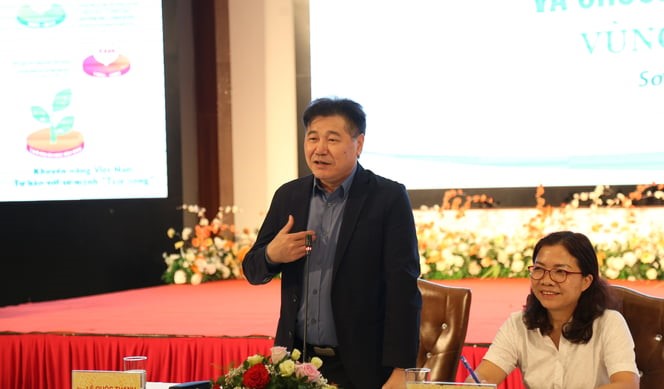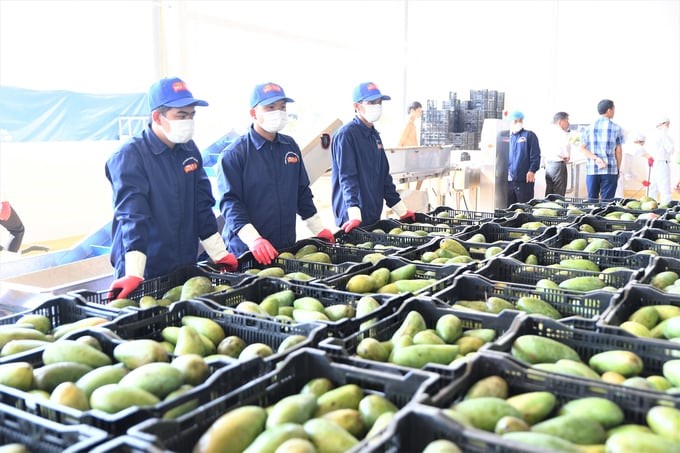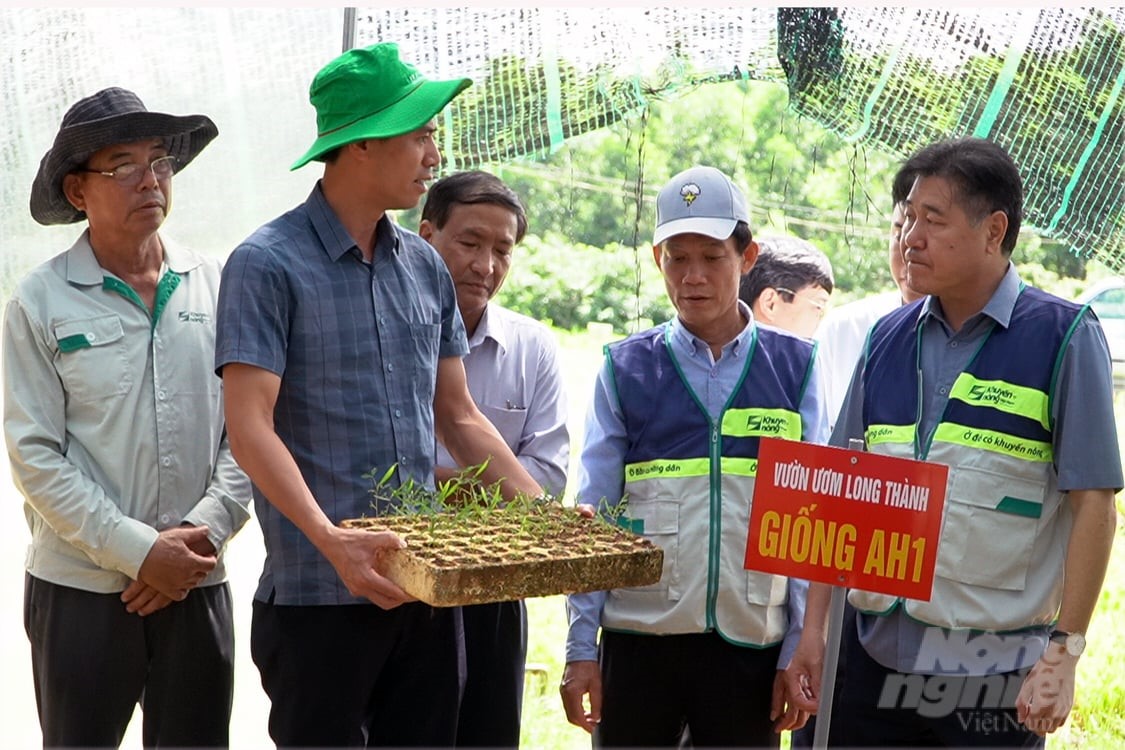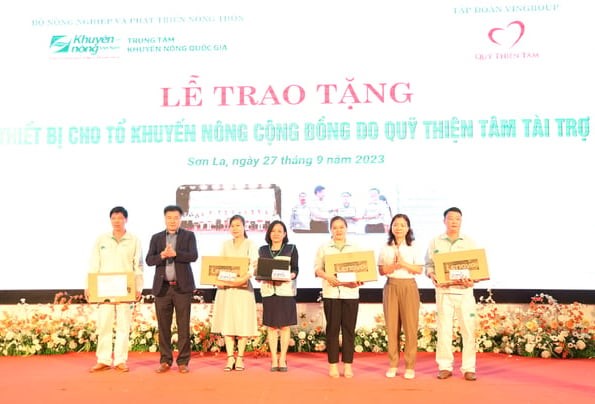May 22, 2025 | 10:52 GMT +7
May 22, 2025 | 10:52 GMT +7
Hotline: 0913.378.918
May 22, 2025 | 10:52 GMT +7
Hotline: 0913.378.918
On September 27, the National Agricultural Extension Center (NAEC) coordinated with the Son La Department of Agriculture and Rural Development to organize the conference "Community Agricultural Extension in Developing Fruit Tree Raw Material Areas and Safe Crop Value Chains in the Northern Mountainous Region."
Decision 318/QD-TTg of the Prime Minister dated March 8 contains a regulation that the commune meeting new rural standards must have an effective community agricultural extension group.

"Grassroots agricultural extension staff are the hub of the community agricultural extension group," Mr. Le Quoc Thanh, Director of the National Agricultural Extension Center, emphasized at the conference. Photo: Lam Hung.
After that, the Project "Strengthen the efficiency of agricultural extension activities based on consolidating the model of community agricultural extension groups" of the Ministry of Agriculture and Rural Development was implemented, and 26 pilot community extension groups were established in 13 provinces belonging to 5 raw material areas. These raw material areas include: fruit tree raw material area in the Northern mountainous region (Hoa Binh, Son La); certified planted forest wood raw material area of the Central Coast (Quang Tri, Thua Thien-Hue); Central Highlands coffee raw material areas (Gia Lai, Dak Lak, Dak Nong, Kon Tum); Long Xuyen Quadrangle rice raw material area (Kien Giang, An Giang); Dong Thap Muoi fruit tree raw material area (Dong Thap, Tien Giang, Long An).
According to Ms. Cam Thi Phong, Deputy Director of the Son La Department of Agriculture and Rural Development, the pilot project to establish community agricultural extension groups in Son La has initially been effective in two localities joining, namely Mai Son and Thuan Chau districts.
The key task of the community agricultural extension group is to support and advise farmer households and cooperatives on agricultural extension. Specifically, consult and support the development of production plans for farmer households, cooperative groups, and cooperatives in accordance with enterprises’ requirements; consult techniques and technological processes in production. Currently, Son La is replicating the community agricultural extension group model in other districts in the province.

Currently, Son La is becoming a large fruit tree barn, attracting many enterprises to invest in. These enterprises are in dire need of cooperation in activities with community agricultural extension. Photo: TL.
"Because they have just been established, community agricultural extension groups are still passive and confused, without specific plans and operating funds; working equipment, tools, and locations are lacking. The composition of the community agricultural extension group is not as multidisciplinary as required and lacks technical staff in animal husbandry and aquaculture. Officials participating in the community extension group still have limited knowledge about market development and cooperative management, linkage according to the value chain, quality management, traceability, etc. Most members of the group are part-time and do not have their own headquarters, so it is still difficult to organize periodic meetings according to regulations,” said Ms. Cam Thi Phong.
Orienting the development of the raw material area chain and safe crop value chain in the North, Mr. Le Quoc Thanh, Director of NAEC, said that NAEC has opened central agricultural extension projects, typically in coordination with the JICA Project Management Board, thereby transferring the most advanced technologies, calling technology units from institutes, schools, and enterprises to accompany farmers, and then building modern models full of technology for farmers to visit and learn.

Community agricultural extension groups initially had effective activities, arousing the community to participate in agricultural extension work. Photo: TL.
In addition, NAEC promoted communication work to help people change their awareness, thinking, and methods while creating a close linkage between cooperatives and enterprises in promoting products and finding consumption markets. NAEC also regularly organizes many training classes to provide farmers with technical training and knowledge of product criteria and standards, thereby orienting farmers towards clean and safe production according to VietGAP, organic standards, etc.
"To form large raw material areas in localities such as Son La, Hoa Binh, etc., currently the most fundamental solution is to cooperate and form large cooperatives linked together. Once small production farmer households are gathered, large raw material areas will be automatically formed," Mr. Le Quoc Thanh suggested.
Responding to delegates' feedback that agricultural extension work at the grassroots level is showing signs of overload and disruption, possibly affecting the effective implementation of the Community Agricultural Extension Group Project, Mr. Thanh said that currently, the Ministry of Agriculture and Rural Development is developing a project to strengthen the capacity of grassroots agricultural extension staff through consolidating community agricultural extension groups. NAEC is assigned the task of accompanying and guiding these two forces to avoid overlapping and separation from each other.

NAEC donated equipment, such as projectors and smartphones, to Son La’s community agricultural extension groups. Photo: Lam Hung.
Regarding the role of grassroots agricultural extension staff, Mr. Thanh affirmed that the grassroots agricultural extension staff is the final and closest bridge to producers. Therefore, much attention needs to be paid to this staff. NAEC hopes that in the process of building a community agricultural extension group, it is mandatory to involve grassroots agricultural extension staff to jointly strengthen each other's capacity, share production activities right in the area, develop operational plans, search for markets, etc.
"Agricultural extension activities are community activities; that's why people with experience need to share with people without experience; people with market information should share with people without information; people with experience in input materials and people knowledgeable about product quality standards must regularly exchange information with each other. Once the community is concerned about agricultural extension activities, we will have sustainable agriculture that both grows and ensures green and ecological development," Mr. Le Quoc Thanh emphasized.
Translated by Huyen Vu Thu
![Reducing emissions from rice fields: [2] Farmers’ commitment to the soil](https://t.ex-cdn.com/nongnghiepmoitruong.vn/608w/files/news/2025/05/05/dsc08881jpg-nongnghiep-140632.jpg)
(VAN) Clean rice cultivation model in Thuong Tan commune, Bac Tan Uyen district, is assisting local residents in achieving sustainable agriculture by substantially reducing costs, increasing productivity, and protecting the environment.

(VAN) At the conference to disseminate Resolution No. 68, AgriS introduced its digital agricultural ecosystem and reaffirmed its commitment to accompanying the Government in promoting private sector development and sustainable agriculture.

(VAN) 'Blue Ocean - Blue Foods' initiative is designed to restore marine ecosystems and establish sustainable livelihoods for local communities by cultivating a minimum of 1,000 hectares of cottonii seaweed in the first three years.
/2025/05/21/4642-3-112707_603.jpg)
(VAN) The V-SCOPE project has made direct contributions to three out of six pillars of the Comprehensive Strategic Partnership between Vietnam and Australia.

(VAN) Facing the threat of rabies spreading to the community, Gia Lai province urgently carries out measures to vaccinate dogs and cats on a large scale.

(VAN) Disease-free livestock farming not only protects livestock herds but also stabilizes production and livelihoods for many farmers in Tuyen Quang.

(VAN) Japan's grant aid project contributes to capacity building, promoting organic agricultural production, and fostering sustainable community development in Dong Thap province.